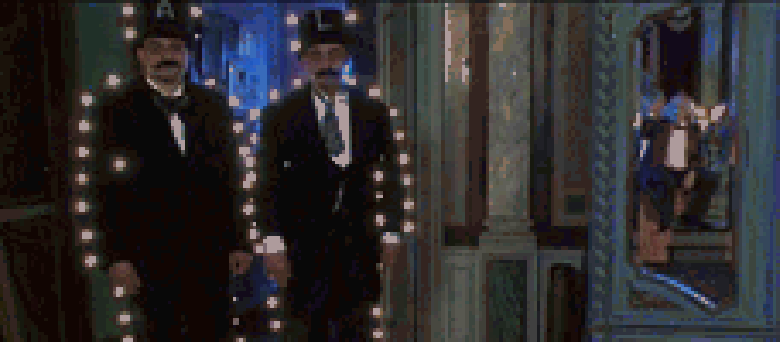Reviews
Les cent et une nuits de Simon Cinéma
Agnès Varda
France, 1995
Credits
Review by Jonathan Foltz
Posted on 05 August 2010
Source MUBI.com
Categories Viva Varda: The Films of Agnès Varda
The centenary of film in 1995 inspired a wave of both serious and loving reflections on the artistic medium that in many ways had defined the culture of the twentieth century. The rise of video and emerging digital technologies created an atmosphere in which it seemed plausible that the material basis of film would soon be irrevocably changed, that cinema as we had known it would disappear — the sort of self-evident truth that is ready-made for mythologies, be they theoretical or commercial. Agnès Varda’s bizarre film, One Hundred and One Nights of Simon Cinema, is the unmistakable byproduct of this discourse of handwringing retrospection, even though she roundly refuses its pseudo-serious tone. Varda’s film is a schizophrenic, and deeply French,1 monument to film’s anarchic jeunesse, filled to the brim with celebrity cameos, iconic (and obscure) references, and knowing reenactments — a vaudeville version of 60s New Wave style. Next to nostalgia projects like the Lumière & Co. omnibus film, the manifesto screeds of Dogme 95, or Godard’s ongoing Histoire(s) du cinema (to which Varda’s film owes an oblique debt), One Hundred and One Nights is decidedly campy and slight. This is clearly a redemptive quality, but it only slightly masks a deep cynicism at the film’s heart.
But first, some introductions! Simon Cinéma (Michel Piccoli), the “human symbol of cinema,” is 100 years old and apparently in declining health. Waited on by his “polymorphous, polyvalent butler” Firmin and two cart-wheeling, plate-spinning maids, M. Cinéma engages a comely young film buff named Camille for 101 afternoon therapy sessions (“between 5 and 7”) to help him remember his passion for film. “I have memories,” he confides to her in an opening scene, “but I can’t remember them… You shall be my evening amphetamine!” He is haunted with astonishing frequency by visions of death, past loves, and by the recurring (but oddly unthreatening) specters of the Lumière brothers, both of whom appear to him in black suits playfully lined with light-bulbs. Marcello Mastroianni, his “Italian friend,” makes repeated visits to reminisce about the golden age of film; Gerard Dépardieu shows up briefly to discuss the art of dying onscreen; Vagabond’s Sandrine Bonnaire wanders in as a homeless youth, only to be magically transformed into Belle from Beauty and the Beast (and then, as if for good measure, Jeanne d’Arc); Alain Delon flies in on his helicopter to pay his respects, only to be waylaid by an over-attentive Firmin; Jean Paul Belmondo appears as Prof. Bèbel, “the world specialist of withering memories.” And more and more: the film often seems like hardly more than a long orgy of celebrity walk-ons that quickly veers into insularity and self-congratulation. No matter how much you appreciate the likes of Catherine Deneuve, Hanna Schygulla, Jeanne Moreau, and Robert DeNiro (who is particularly out of place here), it is disheartening to see them wander onto Varda’s set, mutter a few lines of dialogue that knowingly reference their past glories, and then sharply disappear.
Meanwhile, there is a plot involving Camille’s cinephile and would-be filmmaker boyfriend (played by Varda’s son, Mathieu Demy) and their thwarted scheme to defraud M. Cinéma of his estate, which results in a jealous love-triangle. But all this is merely a convenient scaffolding, a threadbare excuse to relive or at least regurgitate iconic gestures and lines of dialogue from film history. Varda’s fanatical and unrelenting pacing does much to rescue the film from exhaustion (M. Cinéma’s early dictum: “Movement is life! Movement is cinema!” might have served as an on-set motto). Quite apart from the film’s dramatic dead-ends, Varda creates genuine energy by packing each moment so full of stagey banter and elaborate blocking that the effect is unmistakably manic and hypnotic. In this respect, it would be wrong to mistake Varda’s centenary film for the solipsistic elegy it sometimes resembles. “Down with commemorations! Long live anarchy!” M. Cinéma exclaims late in the film. One Hundred and One Nights of Simon Cinéma cannot quite embody the iconoclastic spirit of surrealism it invokes here, but the film at least honors it through its tonal instability.
Other charms are hidden as well. M. Cinéma’s chateau is an extravagant set-piece, almost a separate character in itself, a living, almost sentient film history museum cluttered with props, celebrity portraits, vintage posters, memorabilia, antique camera equipment, and more, all of which shifts vertiginously between (and even in the middle of) scenes, creating a background painstakingly arranged to interact with the dialogue. The butler conspicuously puts his finger to his lips in imitation of a Hitchcock cut-out, while moments later M. Cinéma strikes a pose in the manner of David O. Selznick, inches away from his photo. Varda has created a delirious mise-en-scène, an unending choreography of minor details, that often far outweighs any interest we might have in the performances.
In fact, One Hundred and One Nights is decidedly not about performance, no matter how much it lovingly fetishizes its celebrity guest-stars. In effect, at least, the film is about the abject condition of fandom, in which the pleasure of quoting a favorite line or gesture is shown up as the perverse need to fill experience with the easy license of anonymous images. Varda’s film suffers from this malaise, but it also documents it. Reduced to its impoverished form, cinema can offer nothing more than the two-dimensional version of wish-fulfillment, desire as infinite regress — a promise of enjoyment it will eventually, inevitably break. As it concludes, One Hundred and One Nights of Simon Cinéma offers little hope of an escape from the ruins of such a tradition. Mica, Camille’s film-maker boyfriend, is a deluded “auteur” whose first big enterprise, in a glancing nod to the Tarantino craze current at the time, is a violent genre rehash of gangster tropes — wonderfully titled “The Flower of Blood, or Make ‘Em See Red” — that leaves little hope for future generations, our own included. In an age equally infatuated with the iconographic profundities of Mad Men and the apparent authenticity of homemade aesthetics — from the work of Michel Gondry to commercials for Amazon Kindle — we should be mindful of how much these pleasures owe to the simple act of rediscovering old ideologies in a new package. We can debate the limits of art and commodity more finely within their proximate context, but One Hundred and One Nights of Simon Cinéma offers a potentially unflattering mirror for a culture still manifestly stuck in the rubble of M. Cinéma’s chateau.
- France’s national pride with respect to cinema is clearly satirized in One Hundred and One Nights, but Varda’s film is often offensively chauvinistic in its own right. In a scene in particularly bad taste, a bus load of Japanese tourists are led through M. Cinéma’s estate, as a guide lectures to them only about those Japanese films popular in France. ↩
More Viva Varda: The Films of Agnès Varda
-

Cléo from 5 to 7
1962 -

Le Bonheur
1964 -

Les Créatures
1966 -

Uncle Yanco
1967 -

Black Panthers
1968 -

Lions Love
1969 -

One Sings, the Other Doesn’t
1977 -

Daguerréotypes
1976 -

Mur murs
1981 -

Vagabond
1985 -

Jacquot de Nantes
1991 -

One Hundred and One Nights of Simon Cinéma
1995 -

The Gleaners and I
2000 -

Cinévardaphoto
2004 -

The Beaches of Agnès
2008
We don’t do comments anymore, but you may contact us here or find us on Twitter or Facebook.



